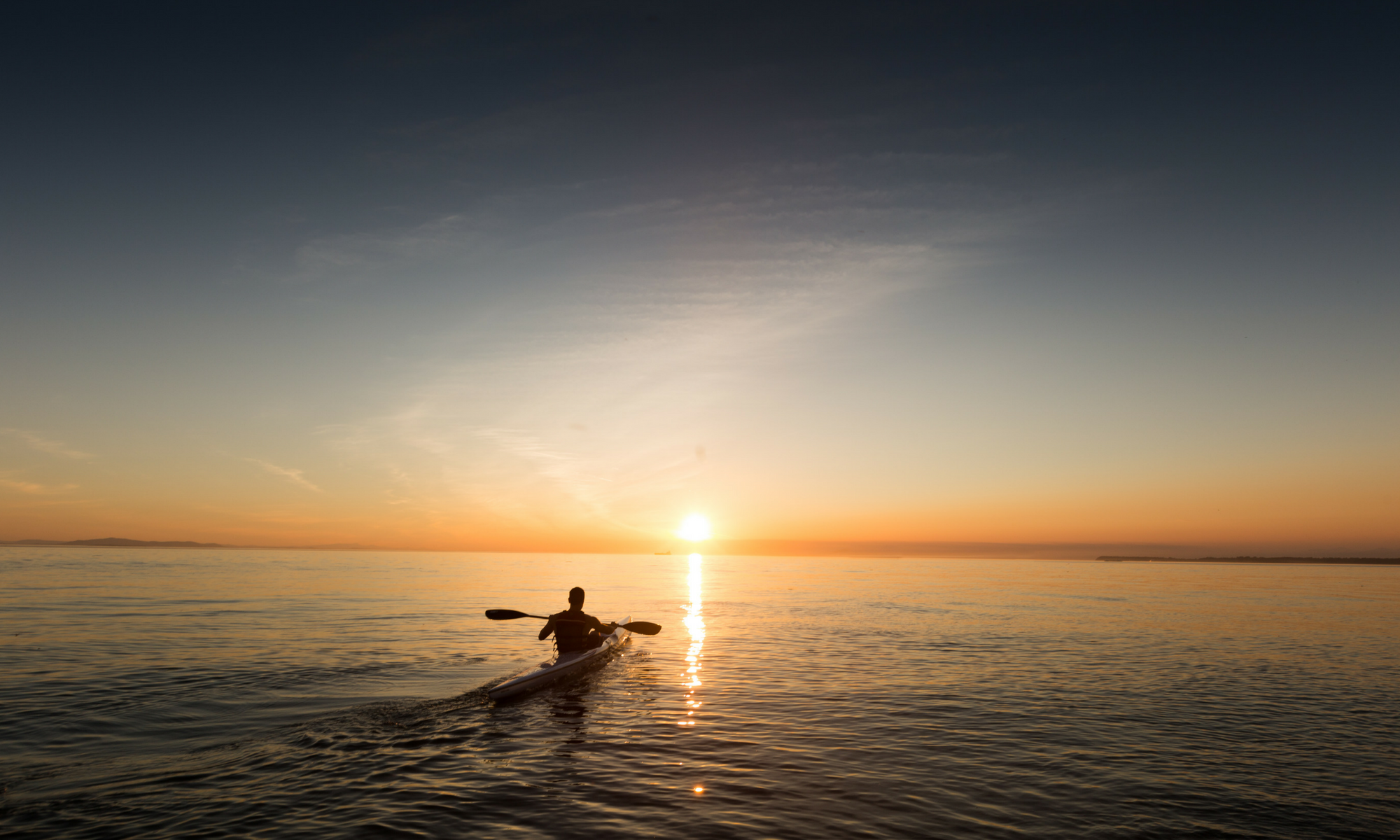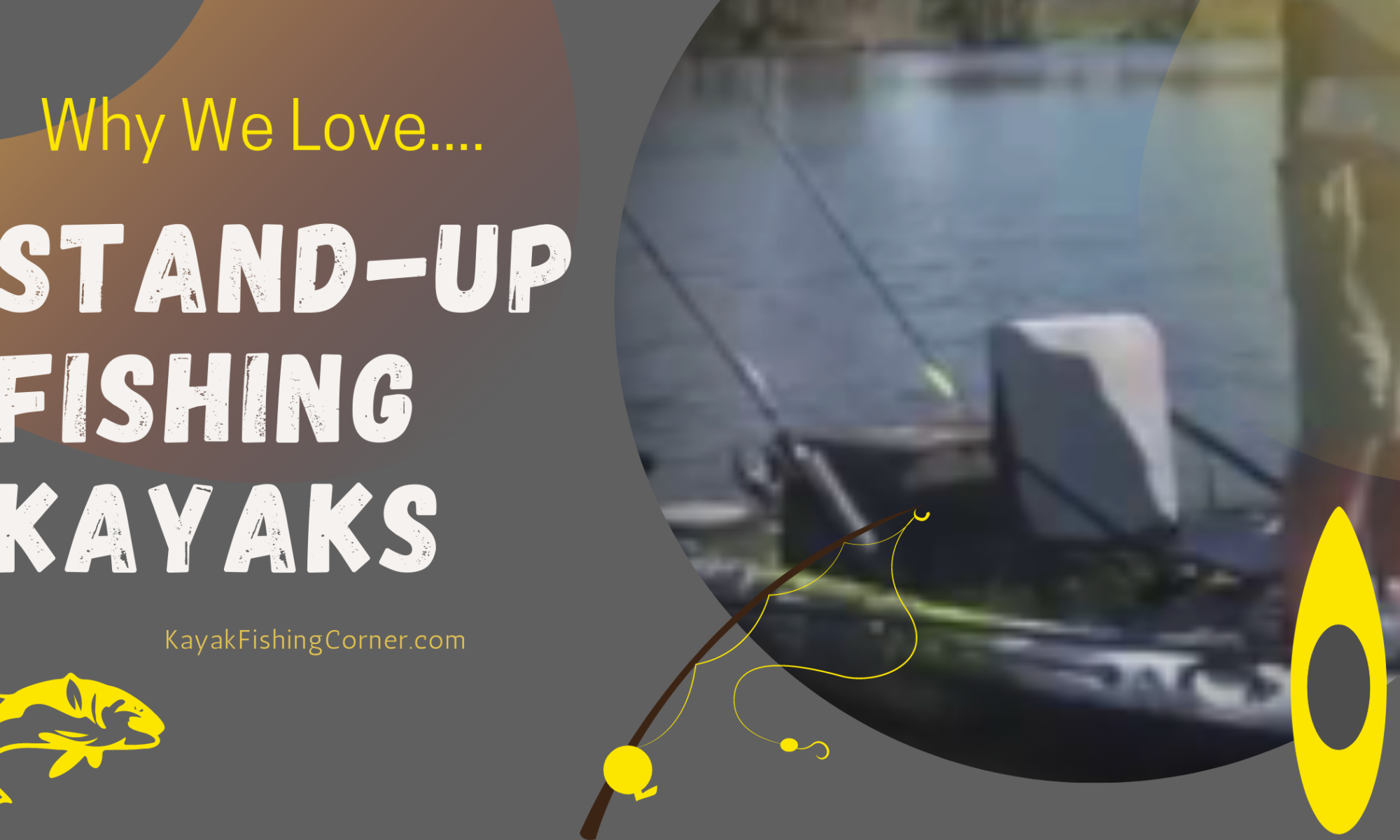Jump Ahead To:
Stand-Up Fishing Kayaks – Intro
Standing at Water Level in Stand-Up Fishing Kayaks Puts You in the Fishing “Zone”!
People who love fishing from a kayak will have many reasons for why they want a kayak they can stand up on. First, it is exhilarating to be out on the water in spring or summertime, even during kayak fishing outings in cold weather where there is a gentle breeze wafting across you and your kayak. Let’s look at three other popular reasons!
Why People Like to Stand up While Fishing in a Kayak

Please note: This post contains affiliate links. An affiliate link means that we may earn advertising/referral fees if you make a purchase through our links.
Good for Your Health
If you have been sitting for a few hours, then it feels good to stand in the breeze once every hour and stretch out those cramped leg muscles! It keeps your blood flowing better through your body than if you were seated for hours on end.
Depending on your kayak’s design, you can also paddle from one place to another while standing, adding some upper-arm exercise in your routine. That always helps you stay in shape!
Get a Better View of Your Prey
If you do not have a fish finder installed, you can stand up and check the water around you to see if any fish are swimming close to the surface. With that in mind, stand up slowly to avoid startling any fish close to you.
Sudden movements around fish close to the surface, including sudden moving shadows, will scare them away.
Casting Further Away from You
Now that you have a possible bead on a few fish, you can build a better force coming from behind you when you cast out than if you were still seated.
First, raise yourself to a standing position in a wide stance. Your stance covers the width, centered over your kayak’s midpoint.
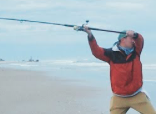
From here, the upper body can turn easily, utilizing that casting arm to release the line at just the right moment to precisely hit the target spot in the water. It is a certain natural flow in the action that synchronizes the cast-out force, the release, and the follow-through moment to hit that target further out.
It is much harder to do this when seated because of the body’s limitation in using only half the body to build the casting force. However, you can increase your casting distance while seated if you have used a kayak anchor (just make sure you are using the Best Kayak Anchor Kit ( learn How to Use a Kayak Anchor Kit)
Stance and Balance are Essential in a Stand-Up Fishing Kayak
Never stand with your feet together if you are casting out. Always keep a centered balance by using an open solid stance across your kayak’s base, allowing for only a slight shift of weight from one leg (and foot) to the other.
You are using the Stand-Up Fishing Kayak’s central balance point as it rests on the water while in the process of casting out! One great option for ensuring optimal balance in Stand-Up Fishing Kayaks is to learn How to Use Kayak Outriggers!
If you have problems with balance (as some of us do), install a cross bar (hip to waist-high), set in, or on top, of your kayak. Lightly hold on to the top while standing and/or casting.
The top of the crossbar, when you touch it, becomes the body’s natural reference point for the boat’s center so you do not lose your balance.
Choose the best position in the kayak of where that crossbar should be installed. You can grab it while standing up. This is important for those who may have disability issues. Add a pull strap to pull your weight forward while beginning to stand up. Grasp the crossbar once you can reach it.
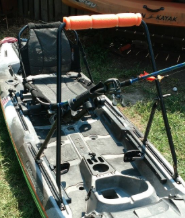
If you are new to kayak fishing and all this talk about balance and positioning sounds a bit “guru-ish,” don’t worry. Practice standing up and sitting down in your kayak while still close to shore and learn how to work with the kayak’s balance (and yours).
Rock the kayak from side to side to know what to expect and how to react to avoid accidental rolling. You will be able to “feel” what you can do while standing, casting, and sitting in the kayak.
Once you have worked out all the kinks in standing from a seated position, sitting back down, and what balance to use while casting, then you are ready to go have fun fishing! Remember to wear your inflatable lifejacket while you are testing your movements and have a friend with you, too, for backup assistance.
Choosing a Kayak Design for Balance While Fishing

Please Note: As an Amazon Associate, I earn from qualifying purchases.
There are many brands and designs of Stand-Up Fishing Kayak, wide, narrow, long, and short, with new designs coming out each year to tickle your interest with new options! When you buy a fishing kayak, purchase the one that has the most design stability and is also suitable for the body of water you plan to fish on.
A wide, flat-bottom SOT (Sit On Top) kayak, as opposed to a narrower v-shaped bottom on a SI (Sit In) kayak, may be your best preferred choice when it comes to standing while fishing. You also have less distance to go while starting to stand up than from a SI kayak where you are starting from a floor seat position.
The flat bottom design kayak also allows you to enter shallow water, especially when you are chasing that pesky fish running away into riverbank weeds. While the longer your kayak is, the faster you can travel. However, a wider kayak will slow you down a bit, but this may not be an issue for you.
Seating Options in Stand-Up Fishing Kayaks
Seating will also be important as part of choosing a kayak as there will be times when you would rather sit to relax for a bit. You want to be as comfortable as possible while seated, especially if you have back and neck issues. Some brands have stationary seating positions while others allow you to slide forward or raise the seat a bit higher.
Look into paddle systems, an add-on for certain brand designs, where you can exercise your legs for as long as you want (until you feel the “burn”), while staying seated. You may prefer to use this natural body energy rather than using your kayak trolling motor (and gas) to get you across that lake or down the river.
Sit-Inside (SI) versus Sit on Top (SOT) Fishing Kayaks

SOT Fishing Kayak
If you choose a Stand-Up Fishing Kayak that has a SOT design, this means your seat bottom is raised level to the top of your kayak edge, or higher. You do not want your seat to be too high up unless you use a ballast system added to the sides of your kayak.
Your kayak should be at least 34-to 35-inches wide (beam) for suitable standing balance. The base of the kayak is more of a platform style with short side raised edges by the seating area.
SOT kayaks are more comfortable as it is easier to stand up while fishing. Add a stand-up rope pull that you can hold, if you need it, then tuck your feet in. Pull yourself forward on the rope until you can stand up.
It is also easier to sit back down again as you have less distance to go before you are seated again. Never just drop down into your seat. Gently ease into it to maintain stability.
Always use slower speeds if moving on the water while in a SOT kayak. If you are moving to another spot that is further away, you might lower your seat to lessen the chance of tipping over.
Example of a SOT Kayak
This link takes you to one version of a SOT kayak that is 35 inches wide and 12’6 inches long. Always check out any videos online for the model(s) that you want to know more about. You will be able to see the kayak in action, what options come with it, and decide if that kayak is what you want.
For this model, the hull is 77 pounds and there are four carry straps which makes it easy for you and your fishing buddy to get it to the water. Once you get it in the water, just tie it off and help your friend get the other kayak into the water. The weight capacity is up to 475 pounds for safe kayaking which includes you and everything you have packed and stored onboard.
Note in the picture that the kayak’s rim sits close to the water and the seat bottom is positioned at (lowest point) just above the rim but installed inside. In front of the seat is a no-slip section which is just about center to the kayak where you can place your feet in a stance while standing.
Even if the kayak you buy does not have this applied, you might like to add it, so you don’t slide or slip while standing. When you use this flatter-surface kayak, you will get water on your kayak’s surface, but there are always drain holes included.
These Stand-Up Fishing Kayaks design models have rear attachment for a motor, and the kayak can be steered using the hand control system or padded foot braces. Other amenities are four flush-mounted fishing rod holds and created holding areas to for resting the fishing rods when done. There are plenty of cargo spaces included as well as a place for installing a fish finder.
Example of a SI Fishing Kayak
The image below shows an SI kayak which has a formed well where the seat is located. Essentially, you are sitting inside the kayak and the seat remains stationary. You can stand up carefully in this SI kayak, but it is a small version with not a lot of width or balance to it.
Chances are you would prefer to remain seated while fishing. There is a small trolling motor in use added to the back end of this kayak. You can attach your paddle to the side or even use a small sail with this size kayak, in case you need more travelling options.
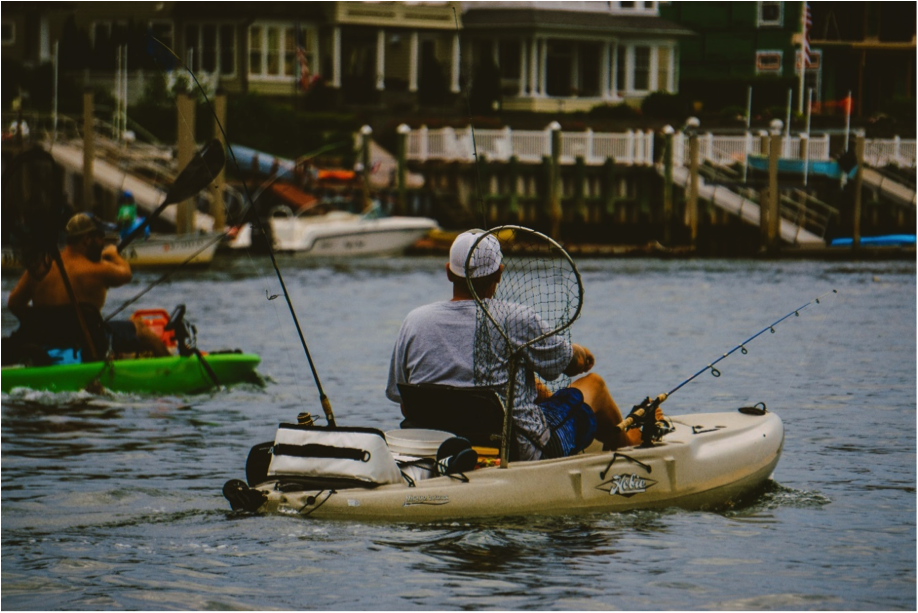
How to Stand Up in a Stand-Up Fishing Kayak
Gather your feet under you and hold on to either side as you begin to get up. Once you are stable while still bent over, you can let go of the sides and raise up the rest of the way to a standing position. Make sure you are in as wide a stance as possible.
The kayaks in the next image below, show different sized wells for seating. The left-side kayak allows only the torso to sit upright out of a close-fitting well. It would be difficult to stand up and fish from this kayak because the kayak is also very narrow.
The right-side kayak has a larger well, adding more open leg room to the front and is also wider. This one has greater stability for standing up to fish. Decide how agile you are if you want to try standing up in one of these Stand-Up Fishing Kayaks.
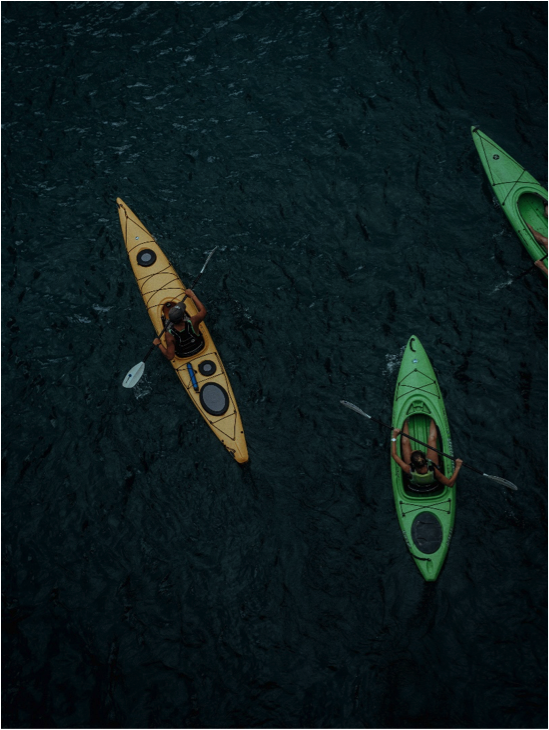
When you are stationary in a fishing position, add on a ballast system on either side that will give you a more secure balance with a SI kayak. There are systems you can add on which raise up or down, depending on whether you are stationary or moving elsewhere. Raise the system up when you begin moving to another area or to head home.
The smaller SI kayaks, overall, are far less stabile for standing up while trying to fish. Many of these also have a V-shaped hull which means you have a greater chance for rolling from one side to another and possibly tipping over. However, you can fish from a seated position except that you have limited upper body movement for casting out.
What to Keep in Mind When Choosing a Stand-Up Fishing Kayak

When deciding on what type of Stand-Up Fishing Kayak you want to use, you can begin by renting different sizes and types of kayaks from an outfitter by your lake or river that you plan to fish on. Do research online to see the different designs there are, as well as viewing prices.
You can also buy a second-hand kayak just to get you started, then decide later about what you really want to have.
Fishing is fun and a great way to put dinner on the table. Plus, you are out on the water enjoying nature, as well as having a friend with you to talk with. You want to be comfortable which means bringing the things that provide more comfort and enjoyment of the fishing sport.
These include your tools, the right fishing rods, tackle box, and your “go-to” waterproof bag with everything in it. Here are some things you should have in mind when making the final choice for your Stand-Up Fishing Kayak, as well as a link to a kayak trolling motor to help you navigate from spot to spot with ease!
- Your weight and height (longer, wider kayak),
- Installing a fish finder,
- Using a pedal system,
- Installing a trolling motor,
- Installing a sail,
- Have enough storage space, preferably in water-tight compartments,
- Rod holders and rod holding wells,
- Anchor,
- Ability to transport the kayak (trailer, truck bed, on the roof- depending on kayak size),
- Carry handles, and
- The biggie – a comfortable seating arrangement (bring your own extra padding, if needed)!
Stand-Up Fishing Kayaks – The Roundup

By now, you know that the best stand-up fishing kayaks for fishing are those which have sit-on-top (SOT) seating arrangements and have at least a 34-to 35-inch width (or beam). Most SOT fishing kayaks run in lengths between 10 to 14 feet long. The beam can also run up to 42 inches across.
These sizes maximize your storage area as well as having a more comfortable seat and the ability to easily stand up while fishing. Choose a longer Stand-Up Fishing Kayak with a wider width that has the SOT arrangement so you can spend more time enjoying your fishing trip and catching more fish. Enjoy!
Comments
So what about you? Do you like to go kayak fishing from stand-up fishing kayaks? Or do you prefer to sit while you are fishing? There is not a “right” or “wrong” answer – in fact, some kayaks are built such that you can alternate between standing and sitting – perhaps you’ve even tried one?
Make sure to reach out to us by posting on the Comments board below. We read and reply to every comment and absolutely LOVE interacting with the kayak fishing community as we share our tips and tricks with one another!
